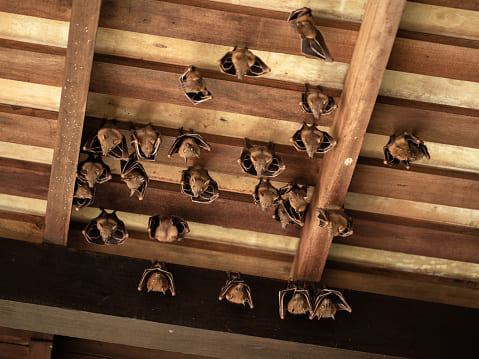How Do Bats Enter A Home?
How Did a Bat Get in My House?
When you suspect that you have a bat infestation in your home, you must act quickly. Bats can transmit disease, cause injury and illness, and damage your property. It’s important to hire a professional to determine the extent of your infestation and create a humane, efficient bat removal plan. At Preferred Wildlife Solutions, we work quickly to determine the best way to get rid of bats in houses in central Minnesota. We can determine how bats got into your house and create a bat prevention plan to ensure the issue doesn’t happen again. Call us now to schedule bat control, removal, and prevention services.

How Do Bats Enter Your Home?
Bats can fit into very small spaces and only need a tiny crack to enter your home. Many species of bats can fit into a hole the width of a pencil by at least one and a half inches wide. Most bats gain entry to homes through cracks or openings in attics, basements, walls, and around windows or doors. They can also enter through open doors and windows and open vents.
What Causes Bats to Enter a Home?
Bats may enter a home if they are looking for a safe, warm, and dry place to roost. They can be drawn to artificial lighting, heat sources, and water sources. They may be looking for easy access to a quiet, dark, and secluded place to roost. If it is cold or raining outside, they may be seeking long-term shelter. They are drawn to homes that offer:
- Cozy, dark, warm spaces to roost, like insulation and attics
- Access to food and water
- Heat or warmth
- Vegetation that offers shelter and foraging opportunities
Where Do Bats Like to Roost in Homes?
Bats like to roost in areas that are quiet, clean, high, and out of the way. The most common places to find bats in homes are:
- Attics
- Roof voids or eaves
- Wall cavities
- Crevices between stonework or behind soffit and fascia
- Chimneys
- Closets
- Crawl spaces
- Utility closets
How to Find a Bat in Your House
If you see any signs of a bat in your house, you should act quickly to minimize damage and reduce health and safety risks. The most common signs of bats in a house are:
- Bat droppings on walls, eaves, floors, fireplaces, hearths, or insulation
- Oily streaks on walls or floors
- Sounds coming from an attic, basement, or closet.
- A pungent odor of urine or feces
- Stains on ceilings
- Damage to wiring, electronics, or insulation.
- Pets behaving strangely and scratching at walls, floors, ceilings, or doors.
The best way to find a bat or bat infestation in your house is to call a professional. Trying to get rid of bats yourself can be dangerous, and disturbing a bat or group of bats when they’re sleeping could cause them to fly at you. When looking for a bat in your home, you should:
- Look in dark, out-of-the-way areas like basements, attics, closets, chimneys, and crawl spaces.
- Listen for sounds like squeaking, chirping, scratching, or thumping.
- Look for signs of droppings.
- Look for scratches on the walls.
- Follow the odor of urine or feces.
How to Get Rid of Bats for Good
The best way to humanely get rid of bats in your home is to hire a professional. A professional can-do a thorough evaluation to determine where the bats are, the extent of the infestation, and how the bats got into your home. They can then use safe, effective, and humane bat removal methods and help you create a plan for bat prevention.
Explore Professional Solutions for Bats in a House
At Preferred Wildlife Solutions, we offer fast, reliable, and humane solutions for bats in houses in central Minnesota. Call us now or contact us online to explore your options for bat control, bat removal, and bat prevention. We will come to your home or business to evaluate the problem and the extent of the infestation. We use safe and humane methods of bat removal and can help you prevent future bat problems.
